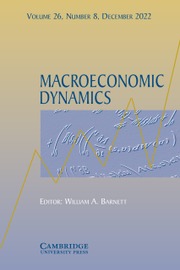No CrossRef data available.
Article contents
On government spending and income inequality under monopolistic competition
Published online by Cambridge University Press: 23 October 2023
Abstract
This paper systematically examines the theoretical and quantitative interrelations between government spending and disposable income inequality in a tractable monopolistically competitive Ramsey macroeconomy. Upon an increase in government size, we analytically show that whether the long-run after-tax Gini coefficient rises or falls depends on the sign and magnitude of the wealth/capital inequality effect versus those of the adjusted-labor effect. Under (i) a mild level of productive public expenditure externalities and (ii) a sufficiently high intertemporal elasticity of consumption substitution, our calibrated model is able to generate qualitatively as well as quantitatively consistent income inequality effects of government spending vis-à-vis recent estimation results.
- Type
- Articles
- Information
- Copyright
- © The Author(s), 2023. Published by Cambridge University Press


